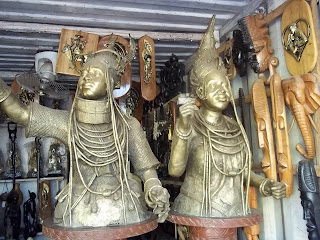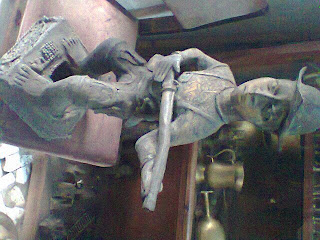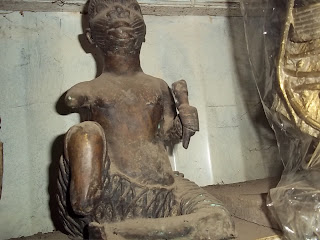Charity they say begins at home. My own PERSONAL JOURNEY TO SELF KNOWLEDGE lead me to embark on a trip to the famous IGUN STREET... Home of the Guild of Benin Bronze Casters: World Heritage Site” is boldly written on the ARCHED OPEN GATEWAY...that leads you into a TOURISTS PARADISE..A beautiful world of Bronze Castings, wood carvings and paintings. Edo state being a land rich in culture started telling their stories and keeping track of history through bronze casting, many ancestors ago. Bronze casting was their own way of telling stories and keeping history through images....A form of photography in those days..With the help of two noble gentle men , Mr Johnbull Enobakhare ,the Managing Director of Enobakhare Arts Gallery and a renown bronze caster , Ebony wood and Ivory carver and his brother Mr Elliot Enobakhare who is by no means a less important personality were more than willing to assist me in this journey of self discovery by sharing and allowing me take pictures of the beautiful bronze artifacts and antiques in their shop which is situated in No 3 , Igun Street, off Sakponba road. They were more than glad to share the stories behind some of these bronze castings and after much research I will share some with you..
OBA EWAKPE AND OUEEN IDEN
 |
| Oba Ewakpe and Oueen Iden. |
Queen Iden the beloved wife of Oba Ewakpe the great was the pride of femine gender, in her days as a Benin Royal Queen who stood behind her husband in a turbulent period. Ewakpe became king in the ancient kingdom in about 1700 A.D. and was the 26th monarch of the hereditary title of Benin dynasty.He reigned for about 12 years which was characterized with series of set backs during the early period to the extent that all subjects in the kingdom revolted against him.
The fundamental cause of grouse was to protest against the monarch's high handedness and his flagrant disrespect of human lives which culminated in the mass killing of his subjects at Uselu during the funeral of his demised mother Queen Ewebonoza in about 17.15 A.D when it became apparent that the elders and the citizens of the Kingdom could no longer accommodate the excesses of the King they were compelled to severe their disreputable connections. This uprising also affected all his wives (Iloi) the royal slaves (ovien) and other palace attendants.
Queen Iden became the only friend of Oba Ewakpe in that time of need, as she made herself present as the kings only hope in time of great calamity when it became apparent that there was no solution to his predicaments, the king decided to seek refuge amongst his mother's relations at IKOKA village but the monarch was also rejected in his matenal abode.
In his sad state of mind he came back to Benin City on the arrival of the Oba, Queen Iden observed his hopelessness and decided to do something about it by consulting an oraclelist on behalf of her husband Oba Ewakpe, to seek the oracle instruction on what should be done to ward off the calamity bedeviling the ancient kingdom and its monarch. After a thorough divination by the oraclist he concluded that all that was needed for the peace of the kingdom and the restoration of its throne was a human sacrifice.
She headed for the palace to give the message of the gods to his majesty the King in their empty harem. The message from the diviner seemed to aggravate matters for Oba Ewuakpe because there was no other human being in his palace, free or bonded beside his dear wife Queen Iden ,who incidentally was the conveyor of this report.
Queen Iden offered herself as a sacrifice to appease the gods in exchange for the restoration of the kingdom and Oba Ewuakpe's royalty.
As soon as Queen Iden suggested to her husband that she submit herself for the supreme price determined by the ancestors, Oba Ewuakpe became nervously embittered as he could not comprehend the possibility of himself killing his dear wife, who had stood with him in times of calamity of this magnitude in order to atone for the sins she had not committed. But the determined Queen encouraged the royal hands to shed her blood. If only that will appease the ancestral spirits of the land of Benin. So as to put aside the upheaval in the kingdom.
And as it became glaring on Oba Ewakpe that there was no other way out of the predicament he conceded reluctantly to the pressure mounted by his real lover the Queen and atone the gods with the precious blood of Queen Iden, as he buried her alive on the spot near the Oba market in the heart of Benin metropolice.
Before Queen Iden voluntarily offered her self as an atonement to the gods, she requested for one favour from the king, that he should make sure her grave side is kept clean at all times. In addition, she cautioned against the reality of any person treading on her grave or else such trespasser should be killed on the spot as a mark of respect for her blessed remembrance.
Consequently her desire was strictly adhered to till the invasion of the British forces in 1897. This Queen had paid the ultimate price requested for by the ancestors but she did not know the outcome of her cherished kingdom and the reign of her beloved husband.
As soon as Oba Ewakpe finished the sacrificial rituals, some of the prominent chiefs in the kingdom called for a trace between the throne and it’s aggrieved subjects. Other Benin Chiefs started paying homage to the Benin monarch again and pledge their loyalty to the bereaved Oba Ewakpe.
Then all other Benin’s came in the same spirit to pledge their allegiance to his authority over them as their king. Consequently, the entire kingdom was reconciled back to the king and remained loyal to the royal majesty till the end of his reign.
Since it was necessary to celebrate such re-union, the Benins came together at the palace and rolled out drums to give such occasion a memorable one. During his happy mood the people were taken back to see their own king weeping profusely in the midst of merriment instead of being happy for the reunion of his subjects with him. This made his subjects to find out from the Oba why he was weeping at the time of celebration , the Oba replied that the motive behind his tears was because of his desire to mourn the sacrificial demise of his dear wife queen Iden.
He went further to narrate all the ordeal in the palace at the time the kingdom fell apart which resulted in the untimely exit of his best friend and beloved Queen who because of her unfeigned love for the unity of her fatherland, offered herself as a scape goat to the gods of her pedigree. For the redemption of their intergenetional equity and social cultural heritage.
Retrospectively therefore, in view of what transpired in Benin Kingdom during the reign of Oba Ewuakpe about 500 yeas ago and the role played by a woman in the person for Queen Iden to ensure the continue existence of Benin monarch is a testimony to the fact that she is the greatest heroine of the millennium. This was culled from EDOWORLD.NET
OBA OVORAMEN
 |
| Oba Ovoramen being taken to Calabar |
In 1892 The British delegation could not be received by the Oba of Benin immediately they arrived because of the need to check out their real mission. When the Oba signaled readiness to receive the delegates, they arrived in encased dress (millitary uniform), to the palace. In other words, they were in military uniform to the palace of an Oba who was weary of visits of Europeans. After the incidence of the Dutchman, Commandant Willem Hogg, who pulled a pistol and shot at Oba Oresoyen in 1735, while on a courtesy visit to the palace to discuss business matters with the Oba and his chiefs, Benin Obas became a little more careful about granting direct audience to European visitors. He had made up his mind before the visit and was looking for excuses to set up Benin kingdom for British invasion. To emphasize that Benin was a special case to crack, the British rushed to force treaties on neighbouring territories. They attacked the Nana of Itsekiri, in their ´palm oil war´ in 1894 and exiled Nana to Ghana; attacked the Koko of Nembe in 1895, and the Ashanti Prempeh of Ashanti in 1896, to produce duress inspired spurious treaties to take control of the kings´ respective areas of influence.
The British accused Oba Ovonramwen of lack of cooperation, and to look good in the eyes of the rest of the world, added human sacrifice, as their reasons for launching their full-scale war on Benin in January 1897. The real reason for the British Expedition was that the British viewed the Benin kingdom as the main obstacle in their expansion drive into the agricultural interior of the West African coast from the River Niger. The war lasted for eight days from January to early February 1897, and went in their favour because of their big guns and cannons, which the Edo army did not have. After capturing the ancient city of Benin and slaughtering thousands of the natives in cold blood, to grossly depopulate the city, and the few survivors had escaped to farms and villages, the British ransacked the palace of the Oba, homes of nobles and chiefs, artistes´ workshops, and shrines, to rescue pagan art and relieve Benin of the evil. Then the British burnt the entire city down to the last house. The palace of the Oba of Benin, according to Joshua Utzheimer, 1603, was about the size of the German City of Tubingen. This was razed down by fire by the British invading force, claiming to be on a civilizing mission. Oba Ovonramwen who could not be captured but who surrendered to the British in August, 1897, was exiled to Calabar (in south-east Nigeria), where he died in January, 1914.
From accounts of members of the British army that invaded Benin City in 1897, we learn that the floors, lintels, and rafters of the council chambers and the king´s residence in the palace were lined with sheets of repoussé, decorated brass covered with royal geometric designs and figures of men and leopards. Ornamental ivory locks sealed the doors and carved ivory figurines surmounted anterior. A brass snake, observed for the first time by a European in the early eighteenth century, was still to be seen on the roof of the council chamber house. All of these, along with other invaluables, including precious works of arts, the invading British stole in the name of their king and country. What they could not steal or burn, they destroyed, including invaluable records of the Bini scintillating civilization, to allow their historians to falsify human history and African contributions. This was culled from Ihuanedo.ning.com
EVBEOTO
 |
| Evbeoto (Palace Slaves) |
THE POT OF LIFE
Traditional West African techniques of lost-wax casting dating to at least the sixteenth century were used to make this intriguing work of art.
In Edo mythology, those who search for and find the pot of life are able to visit the spirit world. There they right the wrongs of injustice. They also encounter a range of beings before returning to the physical world.
 |
| POT OF LIFE |
 |
| Pot of life |
 The lidded bowl is decorated with wild animals and sacred regalia. It sits on a stand composed of two snakes and a base, with a further tableau of wild creatures.
The lidded bowl is decorated with wild animals and sacred regalia. It sits on a stand composed of two snakes and a base, with a further tableau of wild creatures.It is an imaginative exploration of a forest where powerful beings inhabit the borders between the physical and spiritual worlds. Get more info from here
THE LEOPARD HEAD.
In Bini tradition, the LEOPARD is a messenger of the gods and is highly revered. This bronze statue is 120 years old.
 |
| Leopard Head! |
OTHER BRONZE CASTINGS
 |
| An Ancient Hip Mask.. |
 |
| A Mermaid (Mammy Water) |
 |
| more bronze castings. |
 |
| An Ancient Bell used in communicating with the Ancesstors |
 |
| Bronze Leopard |
 |
| Another Ancient bronze casting |
 |
| wood carvings of a boat regalia |
 |
| The famous praying hands done in wood and fibre glass, made to look like bronze for ! |
 |
| bronze Ancestral bell |
 |
| A hunter |
 |
| the arched gateway leading to Igun street. |
According to Wikipedia , Bronze is a metal alloy consisting primarily of copper, usually with tin as the main additive. It is hard and brittle, and it was particularly significant in antiquity, so much so that the Bronze Age was named after the metal. The word bronze is borrowed from French: bronze, itself borrowed from Italian: bronzo (compare Medieval Latin: bronzium), whose origin is unclear. It might be connected with Venetian: bronza "glowing coals", or German: Brunst "fire", but it could equally go back to, or be influenced by, the Latin name Brundisium of the city of Brindisi (aes Brundusinum, meaning "copper of Brindisi", is attested in Pliny). However, perhaps it is ultimately taken from the Persian word for brass,
Igun-Eronmwon quarters popularly known, as Igun Street Benin City {listed as Cultural Heritage Site by UNESCO} is the home of the brass/bronze casting industries in Benin. It constitutes one of the 31 guilds of the Oba of Benin, in the ancient Benin kingdom.
The ancient guild is so secretive and exclusive that outsiders have found virtually impossible to penetrate in the hundreds of years it has existed. All members of the guild are related by a common ancestry and descended of Ine Nigun, the custodian of the street and the bronze casters.
The exact origin of bronze casting in Benin kingdom is hard to establish. What is very certain is that the art has been in practice from primordial reign of the Ogisos, the first royal dynasty without any break, though with discernible chronological stages of development. This ancient craft passed from father to son, from generation to generation continually to this day.
In traditional Benin; before the invasions, of Benin Empire, in 1897 by British forces. The Oba controlled the production and the distribution of brass/bronze arts work no single individual have any right to own any of the production process in those days except with the permission of the Oba of Benin.
The story is very different today, visitors are free to admire, witness bronze casting from the various stages purchase any piece of their choice without let or hindrance. This is probably one of the most patronized tourist attractions in Benin kingdom/Edo state. You can get more info about Igun street and bronze casting from The vanguard .
 |
| Urs sincerly in IGUN STREET..without any form of makeup and rocking an oversized denim jacket..trying the conservative look..aferal na cultural waka! lol |
MARCUS GARVEY...
Just when I was about to upload this post , I caught a glimpse of Joan rivers on T.V wearing a glorious coral necklace while presenting fashion police. Unfortunately many Nigerians especially the youth and celebrities will cringe at the idea of wearing a coral bead bracelet but will gladly adorn their wrists with 2 or more SHAMBALLA bracelets which by the way is a celebration of INDIAN AND TIBETAN cultures. AGAIN I JOIN MARCUS GARVEY IN SAYING...BLACK MAN KNOW THYSELF....







Very gгеat post. Ӏ sіmρlу stumbled uροn yοur wеblog anԁ
ReplyDeleteωanted tο mеntion that І've truly enjoyed browsing your blog posts. After all I will be subscribing to your feed and I am hoping you write again soon!
My web blog ; 1 month loan
I was looking to have further info on Ebony wood suppliers. And there are so many types of wood, from vastly different regions with vastly different characteristics. They all have some distinguishing features what lend the treated wood their personalities.
ReplyDelete